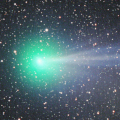
|
It returns for the first time in 70 years. Now it is 4.8 mag (Mar. 29, Katsumi Yoshimoto). It will turn to fade out rapidly after the peak. In the Northern Hemisphere, it will be unobservable in April. In the Southern Hemisphere, it is not observable now, but it will appear in April.
Date(TT) R.A. (2000) Decl. Delta r Elong. m1 Best Time(A, h)
Mar. 30 2 0.44 24 12.8 1.612 0.885 29 5.1 19:45 (112, 11)
Apr. 6 2 30.43 20 1.4 1.610 0.832 25 4.9 19:52 (109, 7)
|
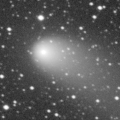
|
It brightened up to 9.6 mag from February to March (Feb. 25, Thomas Lehmann). Now it is 10.8 mag (Mar. 25, Jose Guilherme Aguiar). It will fade out rapidly after this. In the Northern Hemisphere, it stays observable in good condition. In the Southern Hemisphere, it will be unobservable in May.
Date(TT) R.A. (2000) Decl. Delta r Elong. m1 Best Time(A, h)
Mar. 30 19 23.86 20 7.9 1.329 1.474 77 9.9 4:24 (285, 54)
Apr. 6 19 38.53 25 54.2 1.362 1.522 78 10.0 4:13 (276, 57)
|
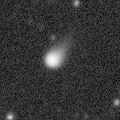
|
It will approach to Sun down to 0.4 a.u. in late September, and it is expected to brighten up to 0 mag. Now it is 11.2 mag (Mar. 19, Osamu Miyazaki). It will brighten rapidly after this. In the Northern Hemisphere, it will be getting lower gradually after this, and it will be unobservable in July. In the Southern Hemisphere, it stays observable in good condition. At the high light, in the Northern Hemisphere, it will be observable in good condition after the perihelion passage. In the Southern Hemisphere, it will be observable in the low sky before and after the perihelion passage.
Date(TT) R.A. (2000) Decl. Delta r Elong. m1 Best Time(A, h)
Mar. 30 14 35.85 -5 12.4 2.283 3.186 149 11.3 2:07 ( 0, 50)
Apr. 6 14 23.34 -4 23.8 2.140 3.096 159 11.1 1:27 ( 0, 50)
|
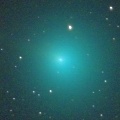
|
It brightened up to 8.9 mag from January to March (Feb. 13, Chris Wyatt). Now it is 11.5 mag (Mar. 27, Osamu Miyazaki). It will fade out rapidly after this. It will be fainter than 18 mag in July. It stays observable in good condition.
Date(TT) R.A. (2000) Decl. Delta r Elong. m1 Best Time(A, h)
Mar. 30 7 3.15 17 10.1 1.128 1.579 95 11.4 19:45 ( 47, 66)
Apr. 6 7 23.65 16 44.1 1.205 1.616 93 11.8 19:52 ( 52, 63)
|
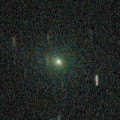
|
It returned for the first time in 68 years. It will brighten up to 7.5 mag in summer. Now it is 11.1 mag (Mar. 27, Osamu Miyazaki). It will brighten rapidly after this. It locates somewhat low in the Northern Hemisphere. In the Southern Hemisphere, it will be unobservable in April. At the high light, it locates low in the Northern Hemisphere, or it is not observable in the Southern Hemisphere.
Date(TT) R.A. (2000) Decl. Delta r Elong. m1 Best Time(A, h)
Mar. 30 3 38.05 14 39.5 2.320 1.785 46 11.9 19:45 ( 91, 25)
Apr. 6 3 48.97 17 14.5 2.312 1.714 42 11.5 19:52 ( 97, 22)
|
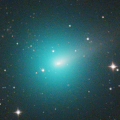
|
It brightened up to 7.4 mag from December to January (Dec. 24, Osamu Miyazaki). Now it is 11.0 mag (Mar. 19, Osamu Miyazaki). Fading rapidly. It will be fainter than 18 mag in June. It stays observable in good condition.
Date(TT) R.A. (2000) Decl. Delta r Elong. m1 Best Time(A, h)
Mar. 30 12 12.42 9 53.2 0.695 1.681 165 12.0 23:39 ( 0, 65)
Apr. 6 12 8.13 9 24.1 0.757 1.730 159 12.5 23:07 ( 0, 64)
|
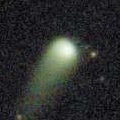
|
Now it is 12.2 mag (Mar. 13, Osamu Miyazaki). It stays 13 mag for a while. It will be unobservable in June. But it will be observable again in July in the Northern Hemisphere.
Date(TT) R.A. (2000) Decl. Delta r Elong. m1 Best Time(A, h)
Mar. 30 7 1.11 29 53.7 3.767 3.962 93 12.6 19:45 ( 78, 73)
Apr. 6 6 56.66 30 34.0 3.880 3.939 85 12.6 19:52 ( 88, 66)
|
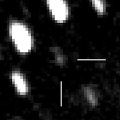
|
The condition is bad in this apparition. It brightens up to 10 mag in early summer, however, it is not observable at all. Brightening gradually. It will never be observable after this.
Date(TT) R.A. (2000) Decl. Delta r Elong. m1 Best Time(A, h)
Mar. 30 1 18.43 2 23.4 2.213 1.247 10 13.1 19:45 (101,-10)
Apr. 6 1 41.12 5 11.7 2.173 1.202 10 12.6 19:52 (105,-11)
|
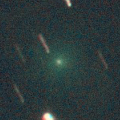
|
First return of a new periodic comet which brightened up to 10 mag in 2001. Now it is 12.8 mag (Mar. 1, Alan Hale). It will fade out rapidly after this. It will be fainter than 18 mag in June. It locates somewhat low in the Northern Hemisphere. In the Southern Hemisphere, it will never be observable after this.
Date(TT) R.A. (2000) Decl. Delta r Elong. m1 Best Time(A, h)
Mar. 30 1 32.76 48 15.0 1.972 1.470 46 13.3 19:45 (137, 19)
Apr. 6 1 56.97 52 10.5 1.986 1.499 47 13.6 19:52 (141, 20)
|
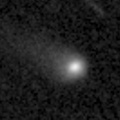
|
Now it is 13.7 mag (Mar. 5, Thomas Lehmann). Fading slowly. In the Northern Hemisphere, it will be unobservable in June. In the Southern Hemisphere, it stays observable in good condition.
Date(TT) R.A. (2000) Decl. Delta r Elong. m1 Best Time(A, h)
Mar. 30 13 2.54 -38 54.3 1.825 2.699 144 13.5 0:35 ( 0, 16)
Apr. 6 12 29.11 -38 54.0 1.812 2.705 146 13.5 23:26 ( 0, 16)
|
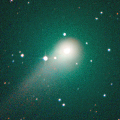
|
It was observed at 9-10 mag for a long time in 2023. Now it is 13.1 mag (Mar. 5, Chris Wyatt). It stays 14 mag for a while. In the Northern Hemisphere, it will never be observable after this. In the Southern Hemisphere, it will be getting higher gradually.
Date(TT) R.A. (2000) Decl. Delta r Elong. m1 Best Time(A, h)
Mar. 30 0 4.58 -40 19.1 4.798 4.147 44 13.6 4:24 (298,-34)
Apr. 6 0 9.29 -40 47.2 4.797 4.204 48 13.6 4:13 (300,-32)
|
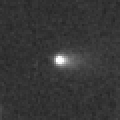
|
It is expected to brighten up to 12 mag in early summer. Now it is 13.4 mag (Mar. 22, Ken-ichi Kadota). Brightening slowly. It stays extremely low in the Northern Hemisphere. But it will become high in summer. In the Southern Hemisphere, it will be unobservable in April. At the high light, it is not observable in the Southern Hemisphere, or it locates low in the Northern Hemisphere.
Date(TT) R.A. (2000) Decl. Delta r Elong. m1 Best Time(A, h)
Mar. 30 2 43.73 10 30.9 2.222 1.483 32 14.0 19:45 ( 95, 12)
Apr. 6 2 52.98 14 27.4 2.208 1.416 28 13.7 19:52 (102, 9)
|
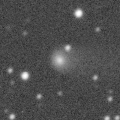
|
Now it is 13.8 mag (Mar. 18, Ken-ichi Kadota). It stays 14 mag for a while. It locates somewhat low in the Northern Hemisphere. But it will become high in winter. In the Southern Hemisphere, it stays observable in good condition.
Date(TT) R.A. (2000) Decl. Delta r Elong. m1 Best Time(A, h)
Mar. 30 12 0.44 -36 0.3 4.273 5.138 146 13.8 23:27 ( 0, 19)
Apr. 6 11 58.00 -35 3.9 4.249 5.125 147 13.7 22:57 ( 0, 20)
|
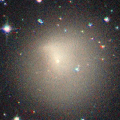
|
Now it is 12.8 mag (Mar. 9, Toshihiko Ikemura, Hirohisa Sato). It will be getting lower gradually after this, and it will be unobservable in June in the Northern Hemisphere, or in July in the Southern Hemisphere.
Date(TT) R.A. (2000) Decl. Delta r Elong. m1 Best Time(A, h)
Mar. 30 8 3.90 21 17.2 5.789 6.190 109 13.8 19:45 ( 13, 76)
Apr. 6 8 4.32 21 10.4 5.899 6.192 102 13.8 19:52 ( 40, 73)
|

|
It has not been observed yet in this apparition. Brightening rapidly. Now it is not observable. It will appear in April in the Southern Hemisphere, or in May in the Northern Hemisphere. It brightens up to 11.5 mag in early summer. But it locates very low around the high light.
Date(TT) R.A. (2000) Decl. Delta r Elong. m1 Best Time(A, h)
Mar. 30 23 36.98 -1 59.3 2.709 1.767 15 14.5 4:24 (265,-10)
Apr. 6 23 53.59 0 35.1 2.659 1.732 17 14.1 4:13 (263, -8)
|
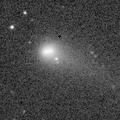
|
Now it is 14.1 mag (Mar. 12, Chris Wyatt). Fading slowly. It will be unobservable in July.
Date(TT) R.A. (2000) Decl. Delta r Elong. m1 Best Time(A, h)
Mar. 30 4 43.70 28 40.3 2.263 2.034 63 14.1 19:45 ( 97, 45)
Apr. 6 5 0.13 29 14.0 2.320 2.029 60 14.1 19:52 (100, 42)
|
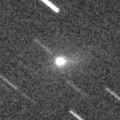
|
First return of a new periodic comet which was discovered in 2011, half a year after the perihelion passage. Now it is 14.5 mag (Mar. 10, Toshihiko Ikemura, Hirohisa Sato). Fading gradually. In the Northern Hemisphere, it will be getting lower gradually. In the Southern Hemisphere, it stays observable in good condition.
Date(TT) R.A. (2000) Decl. Delta r Elong. m1 Best Time(A, h)
Mar. 30 7 47.17 -5 17.4 0.628 1.337 108 14.2 19:45 ( 11, 49)
Apr. 6 7 54.87 -7 16.8 0.627 1.305 104 14.1 19:52 ( 20, 45)
|

|
It brightened up to 8 mag from 2022 summer to 2023 spring. Now it is 13.8 mag (Mar. 12, Chris Wyatt). Fading slowly. It will be getting lower gradually after this, and it will be unobservable in May in the Northern Hemisphere, or in June in the Southern Hemisphere. But it will be observable again in July.
Date(TT) R.A. (2000) Decl. Delta r Elong. m1 Best Time(A, h)
Mar. 30 5 10.37 9 16.0 5.672 5.388 68 14.2 19:45 ( 70, 40)
Apr. 6 5 12.67 9 58.6 5.838 5.448 62 14.3 19:52 ( 77, 34)
|
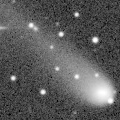
|
Now it is 14.3 mag (Mar. 15, ATLAS Chile). Fading slowly. In the Northern Hemisphere, it will be unobservable in May. In the Southern Hemisphere, it stays observable in good condition.
Date(TT) R.A. (2000) Decl. Delta r Elong. m1 Best Time(A, h)
Mar. 30 7 34.31 -39 52.6 4.510 4.846 103 14.4 19:45 ( 9, 14)
Apr. 6 7 29.45 -38 44.4 4.616 4.885 99 14.5 19:52 ( 17, 14)
|

|
It brightened up to 8.3 mag in 2021-2022 winter (Jan. 6, 2022, Toshiyuki Takahashi). Now it is 13.7 mag (Mar. 7, Thomas Lehmann). It stays 15 mag for a while. In the Northern Hemisphere, it will be unobservable in May. In the Southern Hemisphere, it stays observable in good condition.
Date(TT) R.A. (2000) Decl. Delta r Elong. m1 Best Time(A, h)
Mar. 30 10 47.11 -53 28.5 6.979 7.604 125 14.6 22:14 ( 0, 1)
Apr. 6 10 43.73 -53 4.6 7.022 7.649 125 14.7 21:43 ( 0, 2)
|
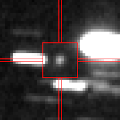
|
It is expected to brighten up to 12.5 mag in summer. Now it is 15.2 mag (Mar. 16, Thomas Lehmann). Brightening slowly. In the Northern Hemisphere, it is not observable now. In the Southern Hemisphere, it stays observable in good condition. Around the high light, it is observable in good condition in the Southern Hemisphere, but it locates very low in the Northern Hemisphere.
Date(TT) R.A. (2000) Decl. Delta r Elong. m1 Best Time(A, h)
Mar. 30 16 47.68 -74 1.1 3.109 3.438 100 14.8 4:19 ( 0,-19)
Apr. 6 16 54.34 -74 57.8 3.002 3.387 104 14.7 3:59 ( 0,-20)
|
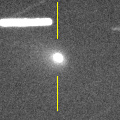
|
It approached to Earth down to 0.2 a.u. and it brightened up to 13.1 mag in March (Mar. 13, W. Pei). Vladimir Bezugly reported it was visible at around 12 mag in the SWAN images in late January. Now it is 15.8 mag (Mar. 19, ATLAS-HKO, Haleakala). Fading rapidly. It will be fainter than 18 mag in May. It stays observable in good condition.
Date(TT) R.A. (2000) Decl. Delta r Elong. m1 Best Time(A, h)
Mar. 30 9 36.21 1 7.4 0.355 1.275 135 14.8 21:06 ( 0, 56)
Apr. 6 10 7.52 2 56.9 0.429 1.342 135 15.4 21:09 ( 0, 58)
|
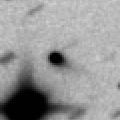
|
It brightened up to 14.5 mag from February to March (Mar. 11, W. Pei). Now it is 15.4 mag (Mar. 23, Ken-ichi Kadota). It will fade out rapidly after this. It will be fainter than 18 mag in June. In the Northern Hemisphere, it stays observable in good condition.
Date(TT) R.A. (2000) Decl. Delta r Elong. m1 Best Time(A, h)
Mar. 30 8 20.79 30 43.7 0.995 1.638 110 15.1 19:49 ( 0, 86)
Apr. 6 8 34.58 29 1.8 1.048 1.648 107 15.2 19:52 ( 30, 83)
|
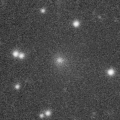
|
Now it is 15.3 mag (Mar. 17, J. E. Rogers, B. Haeusler, D. Parrott). It will fade out rapidly after this. It will be fainter than 18 mag in June. In the Northern Hemisphere, it stays observable in good condition. In the Southern Hemisphere, it will be getting lower gradually.
Date(TT) R.A. (2000) Decl. Delta r Elong. m1 Best Time(A, h)
Mar. 30 16 52.26 -16 7.6 1.003 1.694 115 15.3 4:23 ( 0, 39)
Apr. 6 16 42.19 -8 4.0 0.963 1.742 124 15.3 3:45 ( 0, 47)
|

|
Now it is 15.2 mag (Mar. 18, E. Cortes). It stays 15 mag for a while. In the Northern Hemisphere, it will be unobservable in April. In the Southern Hemisphere, it will be getting higher gradually.
Date(TT) R.A. (2000) Decl. Delta r Elong. m1 Best Time(A, h)
Mar. 30 22 10.98 -15 18.8 2.471 1.828 40 15.4 4:24 (289, 0)
Apr. 6 22 28.69 -13 51.6 2.429 1.825 42 15.4 4:13 (287, 1)
|
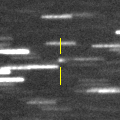
|
Now it is 16.1 mag (Mar. 14, ATLAS Chile). Fading gradually. It will be fainter than 18 mag in July. It stays observable in good condition.
Date(TT) R.A. (2000) Decl. Delta r Elong. m1 Best Time(A, h)
Mar. 30 19 37.56 -11 1.8 1.456 1.543 75 15.5 4:24 (312, 30)
Apr. 6 19 55.61 -10 5.7 1.424 1.555 77 15.5 4:13 (311, 30)
|

|
It brightened up to 12.1 mag in 2023 spring (May 20, 2023, Jose Guilherme de S. Aguiar). Now it is 15.1 mag (Mar. 12, Chris Wyatt). Fading slowly. In the Northern Hemisphere, it is not observable now. In the Southern Hemisphere, it stays observable in good condition.
Date(TT) R.A. (2000) Decl. Delta r Elong. m1 Best Time(A, h)
Mar. 30 4 37.41 -52 56.4 4.488 4.355 75 15.6 19:45 ( 30,-10)
Apr. 6 4 45.01 -50 53.6 4.555 4.400 74 15.7 19:52 ( 35,-11)
|
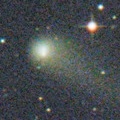
|
It brightened up to 11.1 mag in early 2022 (Mar. 31, 2022, F. Kugel, J.-G. Bosch, J. Nicolas). Now it is 15.6 mag (Mar. 15, ATLAS-MLO, Mauna Loa). It stays 16 mag for a while. In the Northern Hemisphere, it stays observable in good condition. It locates somewhat low in the Southern Hemisphere.
Date(TT) R.A. (2000) Decl. Delta r Elong. m1 Best Time(A, h)
Mar. 30 17 47.38 26 17.9 6.507 6.734 98 15.7 4:24 (304, 76)
Apr. 6 17 47.88 27 13.0 6.480 6.774 102 15.7 4:13 (312, 79)
|
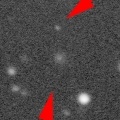
|
It is expected to brighten up to 11.5 mag in 2025 autumn, and it will be observable in good condition. Brightening slowly. It locates somewhat low in the Northern Hemisphere. But it will become high in summer. In the Southern Hemisphere, it will be getting higher gradually.
Date(TT) R.A. (2000) Decl. Delta r Elong. m1 Best Time(A, h)
Mar. 30 22 16.26 -10 9.4 6.398 5.634 37 15.8 4:24 (284, 2)
Apr. 6 22 21.55 -9 35.6 6.289 5.594 42 15.7 4:13 (285, 4)
|
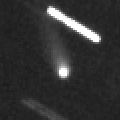
|
Now it is 16.1 mag (Feb. 22, ATLAS Chile). It stays 15 mag for a while. In the Northern Hemisphere, it is not observable now. It locates somewhat low in the Southern Hemisphere. But it will become high in summer. The brightness evolution is slower than originally expected.
Date(TT) R.A. (2000) Decl. Delta r Elong. m1 Best Time(A, h)
Mar. 30 2 18.05 -31 37.3 3.638 2.987 43 15.8 19:45 ( 63,-17)
Apr. 6 2 25.70 -32 2.1 3.605 2.961 43 15.8 19:52 ( 66,-22)
|
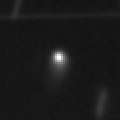
|
Now it is 15.6 mag (Mar. 10, Toshihiko Ikemura, Hirohisa Sato). It stays 16 mag for a while. It will be unobservable in May in the Northern Hemisphere, or in June in the Southern Hemisphere. But it will be observable again in June in the Southern Hemisphere.
Date(TT) R.A. (2000) Decl. Delta r Elong. m1 Best Time(A, h)
Mar. 30 4 41.30 -3 24.6 7.093 6.683 62 15.8 19:45 ( 65, 27)
Apr. 6 4 44.74 -2 44.6 7.151 6.655 56 15.8 19:52 ( 71, 21)
|
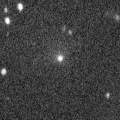
|
Very large comet. It is expected to brighten up to 13 mag in 2031. Now it is 15.3 mag (Mar. 4, Thomas Lehmann). It stays 16 mag for a while. In the Northern Hemisphere, it is not observable now. In the Northern Hemisphere, it is not observable until 2030.
Date(TT) R.A. (2000) Decl. Delta r Elong. m1 Best Time(A, h)
Mar. 30 3 7.39 -61 53.7 16.823 16.538 71 15.8 19:45 ( 31,-25)
Apr. 6 3 10.64 -61 42.9 16.785 16.514 72 15.8 19:52 ( 33,-28)
|
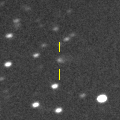
|
Now it is 16.9 mag (Mar. 17, ATLAS Chile). It stays 17 mag for a while. In the Southern Hemisphere, it stays observable in good condition.
Date(TT) R.A. (2000) Decl. Delta r Elong. m1 Best Time(A, h)
Mar. 30 14 14.78 -27 38.9 2.591 3.466 146 16.2 1:45 ( 0, 27)
Apr. 6 14 13.36 -27 1.0 2.552 3.474 153 16.1 1:17 ( 0, 28)
|
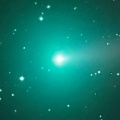
|
It approached to Earth down to 0.38 a.u., and brightened up to 8.0 mag in last autumn (Sept. 29, Virgilio Gonano). Now it is 16.1 mag (Mar. 10, Toshihiko Ikemura, Hirohisa Sato). It will fade out rapidly after this. It will be fainter than 18 mag in May. In the Northern Hemisphere, it will be getting lower gradually. In the Southern Hemisphere, it stays observable in good condition.
Date(TT) R.A. (2000) Decl. Delta r Elong. m1 Best Time(A, h)
Mar. 30 8 13.93 1 47.9 1.677 2.281 114 16.2 19:45 ( 1, 57)
Apr. 6 8 19.85 2 32.5 1.809 2.340 109 16.5 19:52 ( 14, 57)
|

|
It brightened up to 13 mag in early 2023. It stays 17 mag for a while. It stays extremely low in the Northern Hemisphere. In the Southern Hemisphere, it stays observable in good condition.
Date(TT) R.A. (2000) Decl. Delta r Elong. m1 Best Time(A, h)
Mar. 30 16 27.38 -46 53.3 3.702 4.209 114 16.5 3:58 ( 0, 8)
Apr. 6 16 22.03 -46 28.4 3.664 4.268 121 16.5 3:25 ( 0, 8)
|
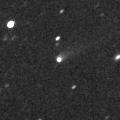
|
Now it is 16.5 mag (Mar. 18, ATLAS Chile). It stays 17 mag for a while. It stays observable in good condition.
Date(TT) R.A. (2000) Decl. Delta r Elong. m1 Best Time(A, h)
Mar. 30 13 0.98 4 9.2 2.580 3.567 169 16.6 0:32 ( 0, 59)
Apr. 6 12 56.15 4 31.2 2.564 3.551 169 16.5 23:55 ( 0, 59)
|
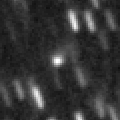
|
Now it is 17.1 mag (Mar. 19, ATLAS Chile). It stays 16 mag for a while. In the Northern Hemisphere, it will be unobservable in July. In the Southern Hemisphere, it stays observable in good condition.
Date(TT) R.A. (2000) Decl. Delta r Elong. m1 Best Time(A, h)
Mar. 30 16 28.79 -50 28.2 5.231 5.688 112 16.6 4:00 ( 0, 4)
Apr. 6 16 19.77 -51 8.4 5.110 5.667 119 16.6 3:23 ( 0, 4)
|
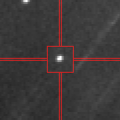
|
Now it is 16.9 mag (Mar. 15, ATLAS Chile). Fading slowly. It will be fainter than 18 mag in July. It will be unobservable in May in the Northern Hemisphere, or in June in the Southern Hemisphere.
Date(TT) R.A. (2000) Decl. Delta r Elong. m1 Best Time(A, h)
Mar. 30 5 32.55 -44 9.1 1.788 1.916 81 16.6 19:45 ( 29, 3)
Apr. 6 5 33.53 -37 15.8 1.858 1.902 77 16.6 19:52 ( 38, 5)
|
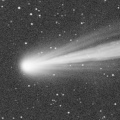
|
It approached to Sun down to 0.23 a.u. and brightened up to 2.5 mag in mid September in 2023 (Sept. 18, 2023, Juan Jose Gonzalez). Now it is 16.6 mag (Mar. 15, Thomas Lehmann). Fading gradually. It will be fainter than 18 mag in May. It stays extremely low in the Northern Hemisphere. In the Southern Hemisphere, it stays observable in good condition.
Date(TT) R.A. (2000) Decl. Delta r Elong. m1 Best Time(A, h)
Mar. 30 8 13.52 -41 28.4 2.973 3.456 110 16.8 19:45 ( 1, 14)
Apr. 6 8 10.26 -39 11.5 3.109 3.543 107 17.0 19:52 ( 8, 15)
|
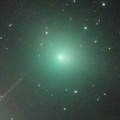
|
It brightened up to 7.8 mag in late July in 2023 (July 20, 2023, Thomas Lehmann). Now it is 16.5 mag (Mar. 18, ATLAS Chile). It will fade out rapidly after this. It will be fainter than 18 mag in May. It stays observable in good condition.
Date(TT) R.A. (2000) Decl. Delta r Elong. m1 Best Time(A, h)
Mar. 30 13 26.59 17 38.6 2.477 3.409 155 16.8 0:58 ( 0, 72)
Apr. 6 13 10.80 19 17.2 2.550 3.478 154 17.0 0:15 ( 0, 74)
|
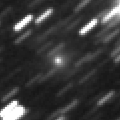
|
Very far object. Now it is 17.1 mag (Feb. 28, ATLAS Chile). It stays 17 mag for a while. In the Northern Hemisphere, it is not observable now.
Date(TT) R.A. (2000) Decl. Delta r Elong. m1 Best Time(A, h)
Mar. 30 2 23.04 -65 10.6 10.608 10.338 71 16.8 19:45 ( 29,-31)
Apr. 6 2 26.14 -64 40.9 10.591 10.341 72 16.8 19:52 ( 31,-34)
|
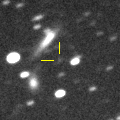
|
Now it is 16.6 mag (Mar. 9, Toshihiko Ikemura, Hirohisa Sato). It stays 17 mag for a while. It locates somewhat low in the Northern Hemisphere. In the Southern Hemisphere, it stays observable in good condition.
Date(TT) R.A. (2000) Decl. Delta r Elong. m1 Best Time(A, h)
Mar. 30 16 3.35 -29 53.3 2.488 3.160 124 17.0 3:34 ( 0, 25)
Apr. 6 16 3.39 -29 55.8 2.410 3.159 131 16.9 3:06 ( 0, 25)
|
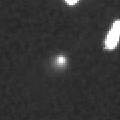
|
Now it is 16.7 mag (Mar. 16, ATLAS Chile). It stays 17 mag for a while. In the Northern Hemisphere, it will be unobservable in April. In the Southern Hemisphere, it will be getting lower gradually. But it will be getting higher again after June.
Date(TT) R.A. (2000) Decl. Delta r Elong. m1 Best Time(A, h)
Mar. 30 4 59.24 -30 34.8 7.658 7.405 71 17.0 19:45 ( 42, 10)
Apr. 6 5 2.88 -29 46.5 7.693 7.384 68 17.0 19:52 ( 47, 6)
|
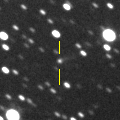
|
Now it is 17.2 mag (Mar. 2, Toshihiko Ikemura, Hirohisa Sato). It stays 17 mag for a while. It will be unobservable in May.
Date(TT) R.A. (2000) Decl. Delta r Elong. m1 Best Time(A, h)
Mar. 30 4 59.91 26 9.2 5.219 4.918 67 17.0 19:45 ( 92, 47)
Apr. 6 5 5.51 25 45.5 5.307 4.907 61 17.0 19:52 ( 95, 41)
|
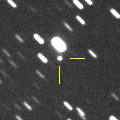
|
Now it is 16.5 mag (Mar. 15, Yukihiro Sugiyama). Fading gradually. It will be fainter than 18 mag in May. In the Southern Hemisphere, it stays observable in good condition.
Date(TT) R.A. (2000) Decl. Delta r Elong. m1 Best Time(A, h)
Mar. 30 8 46.76 -16 6.7 1.000 1.754 122 17.0 20:14 ( 0, 39)
Apr. 6 8 53.75 -15 45.8 1.044 1.762 119 17.1 19:54 ( 0, 39)
|
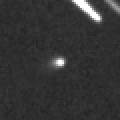
|
Now it is 16.9 mag (Mar. 2, Toshihiko Ikemura, Hirohisa Sato). It stays 17 mag for a while. It stays observable in good condition.
Date(TT) R.A. (2000) Decl. Delta r Elong. m1 Best Time(A, h)
Mar. 30 10 23.48 11 49.7 4.837 5.675 143 17.2 21:50 ( 0, 67)
Apr. 6 10 19.75 12 56.0 4.880 5.640 135 17.2 21:19 ( 0, 68)
|
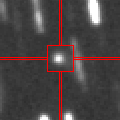
|
Now it is 16.6 mag (Mar. 9, Toshihiko Ikemura, Hirohisa Sato). It stays 17 mag for a while. In the Northern Hemisphere, it will be getting lower gradually after this, and it will be unobservable in June. In the Southern Hemisphere, it stays observable in good condition.
Date(TT) R.A. (2000) Decl. Delta r Elong. m1 Best Time(A, h)
Mar. 30 7 43.69 -7 14.3 4.046 4.451 107 17.2 19:45 ( 12, 47)
Apr. 6 7 45.35 -6 51.8 4.098 4.415 101 17.2 19:52 ( 24, 45)
|
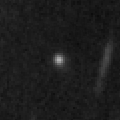
|
It will brighten up to 14 mag from summer to autumn. Now it is 18.2 mag (Mar. 17, ATLAS Chile). It will brighten rapidly after this. It stays observable in good condition. Around the high light, it is observable in good condition in the Southern Hemisphere. But it locates extremely low in the Northern Hemisphere.
Date(TT) R.A. (2000) Decl. Delta r Elong. m1 Best Time(A, h)
Mar. 30 13 7.62 -21 46.5 1.436 2.400 160 17.5 0:39 ( 0, 33)
Apr. 6 13 0.94 -21 42.6 1.379 2.359 164 17.2 0:04 ( 0, 33)
|
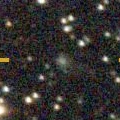
|
Now it is 17.0 mag (Mar. 2, ATLAS-HKO, Haleakala). It stays 17 mag for a while. It will be unobservable in April in the Southern Hemisphere, or in June in the Northern Hemisphere. But it will be observable again in July in the Northern Hemisphere.
Date(TT) R.A. (2000) Decl. Delta r Elong. m1 Best Time(A, h)
Mar. 30 4 53.42 39 5.3 7.021 6.713 68 17.3 19:45 (111, 50)
Apr. 6 4 58.31 38 59.8 7.121 6.717 62 17.3 19:52 (113, 44)
|
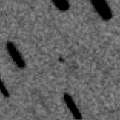
|
It stays 17 mag for a while. It stays observable in good condition.
Date(TT) R.A. (2000) Decl. Delta r Elong. m1 Best Time(A, h)
Mar. 30 15 34.92 -9 0.5 2.136 2.928 134 17.5 3:05 ( 0, 46)
Apr. 6 15 34.29 -8 7.3 2.068 2.920 141 17.4 2:37 ( 0, 47)
|
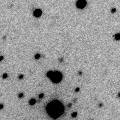
|
Now it is 17.8 mag (Mar. 16, ATLAS South Africa). It stays 17 mag for a while. In the Northern Hemisphere, it will be unobservable in April. In the Southern Hemisphere, it stays observable in good condition. It stays 15 mag for a long time from late 2024 to early 2026.
Date(TT) R.A. (2000) Decl. Delta r Elong. m1 Best Time(A, h)
Mar. 30 6 3.60 -48 10.7 5.326 5.378 87 17.4 19:45 ( 22, 2)
Apr. 6 6 5.85 -46 19.4 5.326 5.339 85 17.4 19:52 ( 27, 1)
|
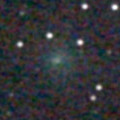
|
It must have brightened up to 11 mag in winter. However, it was too low to observe at the high light. Now it is 16.6 mag (Mar. 19, ATLAS South Africa). Fading rapidly. It will be fainter than 18 mag in April. It stays observable in good condition.
Date(TT) R.A. (2000) Decl. Delta r Elong. m1 Best Time(A, h)
Mar. 30 18 8.28 -18 21.2 0.967 1.477 97 17.5 4:24 (338, 34)
Apr. 6 17 31.18 -12 59.1 0.878 1.569 113 17.7 4:13 (353, 42)
|

|
It will brighten up to 16 mag in summer. Brightening slowly. It stays extremely low in the Northern Hemisphere. But it will become high in summer. In the Southern Hemisphere, it stays observable in good condition.
Date(TT) R.A. (2000) Decl. Delta r Elong. m1 Best Time(A, h)
Mar. 30 21 20.65 -25 39.6 2.631 2.222 55 17.7 4:24 (304, 3)
Apr. 6 21 35.63 -24 54.8 2.570 2.223 58 17.6 4:13 (304, 3)
|
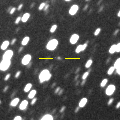
|
Now it is 17.4 mag (Mar. 6, A. Diepvens). Fading slowly. It will be fainter than 18 mag in May. In the Northern Hemisphere, it stays observable in good condition. It locates somewhat low in the Southern Hemisphere.
Date(TT) R.A. (2000) Decl. Delta r Elong. m1 Best Time(A, h)
Mar. 30 7 9.13 23 15.2 2.078 2.403 96 17.6 19:45 ( 56, 71)
Apr. 6 7 17.36 23 30.3 2.158 2.400 91 17.7 19:52 ( 67, 67)
|
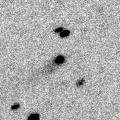
|
Now it is 17.4 mag (Mar. 6, ATLAS-MLO, Mauna Loa). It stays 18 mag for a while. It stays observable in good condition.
Date(TT) R.A. (2000) Decl. Delta r Elong. m1 Best Time(A, h)
Mar. 30 11 47.52 20 54.5 8.623 9.522 152 17.6 23:14 ( 0, 76)
Apr. 6 11 43.17 21 16.6 8.687 9.537 146 17.7 22:42 ( 0, 76)
|
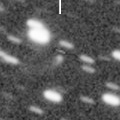
|
Now it is 17.7 mag (Jan. 9, Toshihiko Ikemura, Hirohisa Sato). It stays 18 mag for a while. In the Northern Hemisphere, it will be getting higher gradually. In the Southern Hemisphere, it is not observable now, but it will appear in April.
Date(TT) R.A. (2000) Decl. Delta r Elong. m1 Best Time(A, h)
Mar. 30 22 49.67 38 23.7 4.889 4.202 42 17.7 4:24 (237, 22)
Apr. 6 22 50.62 38 58.7 4.869 4.203 43 17.7 4:13 (238, 25)
|
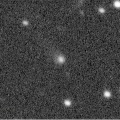
|
Now it is 17.9 mag (Mar. 16, ATLAS South Africa). It stays 18 mag for a while. In the Northern Hemisphere, it will never be observable after this. In the Southern Hemisphere, it will be getting lower gradually.
Date(TT) R.A. (2000) Decl. Delta r Elong. m1 Best Time(A, h)
Mar. 30 4 16.51 -62 22.5 4.127 4.043 78 17.8 19:45 ( 25,-19)
Apr. 6 4 16.10 -61 17.6 4.164 4.068 77 17.8 19:52 ( 29,-21)
|
|
![]()
 32P/Comas Sola
32P/Comas Sola 479P/2023 WM26 ( Elenin )
479P/2023 WM26 ( Elenin ) C/2017 K2 ( PanSTARRS )
C/2017 K2 ( PanSTARRS ) C/2019 U5 ( PanSTARRS )
C/2019 U5 ( PanSTARRS ) C/2019 L3 ( ATLAS )
C/2019 L3 ( ATLAS ) C/2023 C2 ( ATLAS )
C/2023 C2 ( ATLAS ) 207P/NEAT
207P/NEAT 227P/Catalina-LINEAR
227P/Catalina-LINEAR C/2024 C4 ( ATLAS )
C/2024 C4 ( ATLAS ) 130P/McNaught-Hughes
130P/McNaught-Hughes 125P/Spacewatch
125P/Spacewatch C/2020 K1 ( PanSTARRS )
C/2020 K1 ( PanSTARRS ) C/2019 T4 ( ATLAS )
C/2019 T4 ( ATLAS ) C/2022 N2 ( PanSTARRS )
C/2022 N2 ( PanSTARRS ) C/2022 S4 ( Lemmon )
C/2022 S4 ( Lemmon ) C/2022 QE78 ( ATLAS )
C/2022 QE78 ( ATLAS ) C/2014 UN271 ( Bernardinelli-Bernstein )
C/2014 UN271 ( Bernardinelli-Bernstein ) C/2022 T1 ( Lemmon )
C/2022 T1 ( Lemmon ) 103P/Hartley 2
103P/Hartley 2 C/2021 Y1 ( ATLAS )
C/2021 Y1 ( ATLAS ) 65P/Gunn
65P/Gunn C/2023 F3 ( ATLAS )
C/2023 F3 ( ATLAS ) C/2024 A2 ( ATLAS )
C/2024 A2 ( ATLAS ) C/2023 P1 ( Nishimura )
C/2023 P1 ( Nishimura ) C/2021 T4 ( Lemmon )
C/2021 T4 ( Lemmon ) C/2019 E3 ( ATLAS )
C/2019 E3 ( ATLAS ) 299P/Catalina-PanSTARRS
299P/Catalina-PanSTARRS C/2022 R6 ( PanSTARRS )
C/2022 R6 ( PanSTARRS ) C/2022 U3 ( Bok )
C/2022 U3 ( Bok ) 150P/LONEOS
150P/LONEOS C/2023 H5 ( Lemmon )
C/2023 H5 ( Lemmon ) C/2023 T3 ( Fuls )
C/2023 T3 ( Fuls ) 37P/Forbes
37P/Forbes C/2021 S4 ( Tsuchinshan )
C/2021 S4 ( Tsuchinshan ) 362P/(457175) 2008 GO98
362P/(457175) 2008 GO98 C/2024 A1 ( ATLAS )
C/2024 A1 ( ATLAS ) C/2023 S3 ( Lemmon )
C/2023 S3 ( Lemmon ) 89P/Russell 2
89P/Russell 2 478P/2023 Y3 ( ATLAS )
478P/2023 Y3 ( ATLAS ) C/2020 F2 ( ATLAS )
C/2020 F2 ( ATLAS ) C/2022 U1 ( Leonard )
C/2022 U1 ( Leonard ) C/2022 A3 ( Lemmon-ATLAS )
C/2022 A3 ( Lemmon-ATLAS )![]()





















































